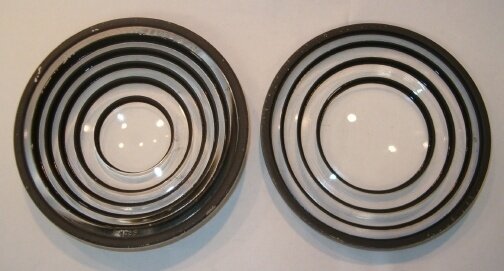A step, or stepped, lens was used in some medium to long throw ERSs from the 1940s through the 1980s. With any lens, only the outer surfaces refract light, so theoretically removing the material in between makes no difference optically.
Step lenses and Fresnel lens differ only in which surface is moved toward the other when the glass in the middle is removed. A fresnel lens keeps the plano surface, and moves the convex side. The step lens keeps the curved (convex) side and moves the plano side.

The problem comes when light hits the "steps" that are perpendicular to the flat surface. On a step lens, these risers are painted black, which leads to concentric rings visible in the beam, the "bullseye effect."

In a Fresnel lens, the flat surface is textured or stippled, to slightly diffuse the light. On the ETC SourceFour 5° and 10° ERSs, a "micro-groove plastic fresnel lens" is used as glass would be too heavy, as evidenced by the fixtures these replaced, specifically the 8x13 and 10x23 ERSs which were notoriously nose-heavy. This lens is similar to that used on the bed of an overhead projector, and is also used on the HES Showgun.
Step lenses and Fresnel lens differ only in which surface is moved toward the other when the glass in the middle is removed. A fresnel lens keeps the plano surface, and moves the convex side. The step lens keeps the curved (convex) side and moves the plano side.

The problem comes when light hits the "steps" that are perpendicular to the flat surface. On a step lens, these risers are painted black, which leads to concentric rings visible in the beam, the "bullseye effect."

In a Fresnel lens, the flat surface is textured or stippled, to slightly diffuse the light. On the ETC SourceFour 5° and 10° ERSs, a "micro-groove plastic fresnel lens" is used as glass would be too heavy, as evidenced by the fixtures these replaced, specifically the 8x13 and 10x23 ERSs which were notoriously nose-heavy. This lens is similar to that used on the bed of an overhead projector, and is also used on the HES Showgun.
Last edited:


